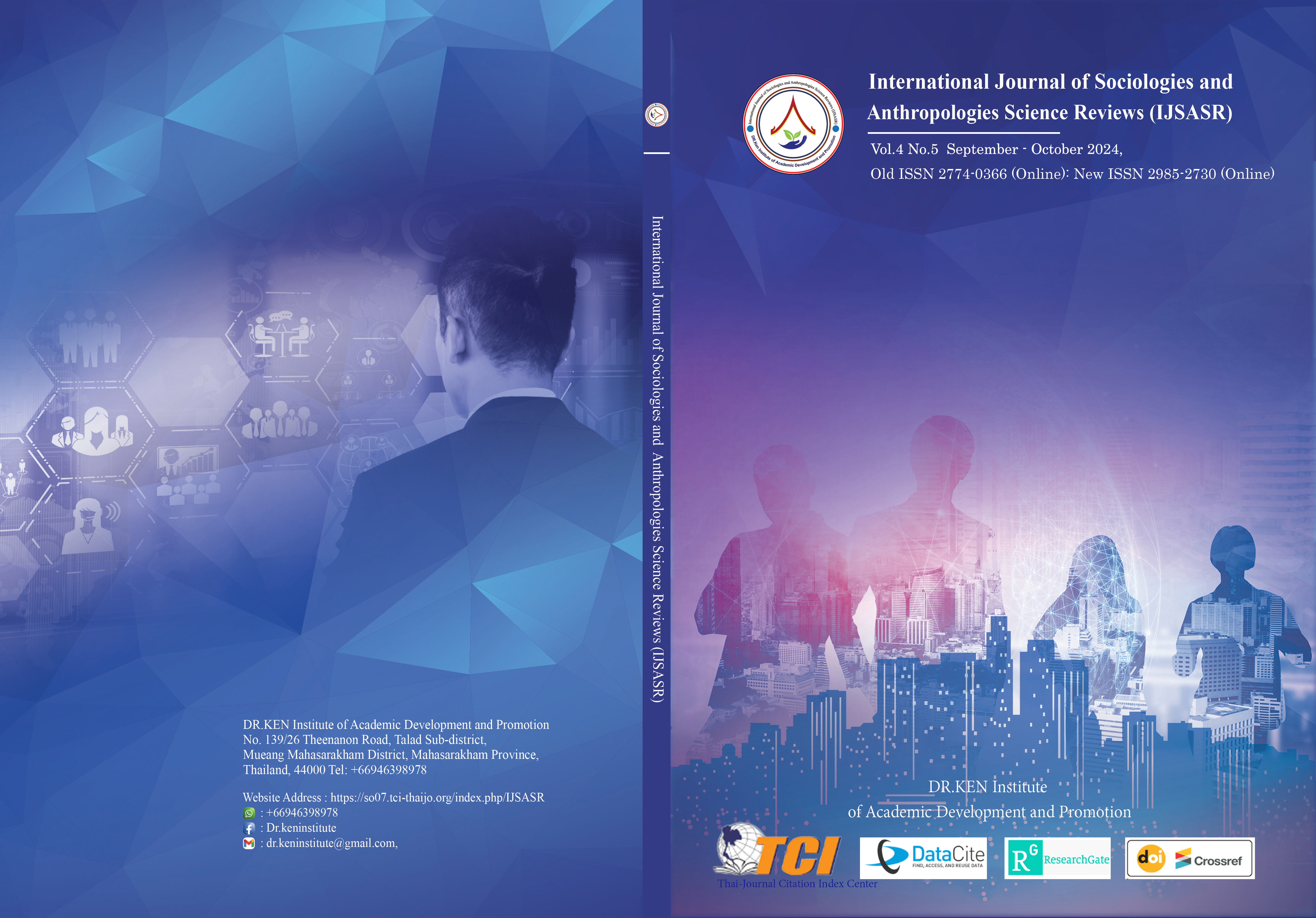A Brief Overview of Music Therapy Content for Practitioners
Main Article Content
Abstract
Background and Aim: Chinese five-tone music therapy has developed in response to mental health issues. This article provides a briefing on music therapy, music therapeutic practice, and surveying the practice of music therapy. The authors evaluate pertinent papers from studies published outside of China from 2003 to 2023, recommend five publications from experts, and then extract and retrieve scholarly pieces.
Methodology: This paper is documentary research by reviewing the literature related and using the content analysis.
Results: Music therapy, originating in Vienna around 1820, uses music, rhythm, sound, and melody to address physical, emotional, cognitive, social, and psychological needs. It has applications in neonatology, pediatrics, and traditional Chinese five-tone music therapy. The BARIT model and model combine the disciplines of music, medicine, and psychology to target mental health concerns. Music therapists value authenticity and seek training in various styles, genres, instruments, and skills. They believe in the benefits of music therapy for patients and staff and recommend expanding the program, hiring more therapists, increasing daily sessions, and creating a dedicated space.
Conclusion: The article discusses the role of music therapy in helping young people with mental health emergencies, highlighting its benefits in behavioral changes and improved engagement. It suggests using surveys and interviews to create a research framework and develop a tool for developmental study and practical application in the classroom.
Article Details

This work is licensed under a Creative Commons Attribution-NonCommercial-NoDerivatives 4.0 International License.
Copyright on any article in the International Journal of Sociologies and Anthropologies Science Reviews is retained by the author(s) under the under the Creative Commons Attribution-NonCommercial-NoDerivatives 4.0 International License. Permission to use text, content, images, etc. of publication. Any user to read, download, copy, distribute, print, search, or link to the full texts of articles, crawl them for indexing, pass them as data to software, or use them for any other lawful purpose. But do not use it for commercial use or with the intent to benefit any business.

References
Avers, L., Mathur, A., & Kamat, D. (2007). Music therapy in pediatrics. Clinical pediatrics, 46(7), 575-579.
Chang, N.W. (2023). The Role and Function of Music Therapy in Child-Friendly Healthcare. Hu Li Za Zhi, 70(3), 12-18.
Freitas, C., Fernández-Company, J.F., Pita, M.F., & Garcia-Rodriguez, M. (2022). Music therapy for adolescents with psychiatric disorders: An overview. Clinical child psychology and psychiatry, 27(3), 895-910.
Geipel, J., Koenig, J., Hillecke, T.K., Resch, F., & Kaess, M. (2018). Music-based interventions to reduce internalizing symptoms in children and adolescents: A meta-analysis. Journal of Affective Disorders, 22(5), 647-656.
Giordano, F., Muggeo, P., Rutigliano, C., Barzaghi, F., Battisti, L., Coccia, P., & Cesaro, S. (2023). Use of music therapy in pediatric oncology: an Italian AIEOP multicentric survey study in the era of COVID-19. European Journal of Pediatrics, 182(2), 689-696.
Johnson, K., & Heiderscheit, A. (2018). A survey of music therapy methods on adolescent inpatient mental health units. Journal of music therapy, 55(4), 463-488. doi:10.1093/jmt/thy015
Kern, P., & Tague, D.B. (2017). Music therapy practice status and trends worldwide: An international survey study. The Journal of Music Therapy, 54(3), 255-286.
Khan, W.U., Yap, I.A.M.O., O'Neill, D., & Moss, H. (2016). Perceptions of music therapy for older people among healthcare professionals. Medical Humanities, 42(1), 52-56.
Kwon, C.-Y., Kim, H., Kim, S.-H. (2024). The Modernization of Oriental Music Therapy: Five-Element Music Therapy Combined with Artificial Intelligence. Healthcare, 12(3),411-412. https://doi.org/10.3390/healthcare12030411
Liu, H., Tian, S., & Tan, H. (2023). Music Therapy and Functional Music: How Worked with Mirror Neuron System. https://doi.org/10.31219/osf.io/h7v3b
Mahon, E.M., & Mahon, S.M. (2011). Music therapy: a valuable adjunct in the oncology setting. Clinical journal of oncology nursing, 15(4), 353.
Mastnak, W. (2022). Chinese Music Therapy and Clinical Music Education to treat Anxiety Disorders: The PLUS-Model. MODERN APPLIED MEDICAL RESEARCH. Doi: 10.36099/mamr.210222.
Meng, F., & Xue, Y. (2023). A New Understanding of Orff Music Therapy. LNEP (Lecture Notes in Education Psychology and Public Media). 3, 924-929. DOI: 10.54254/2753-7048/3/2022428.
Molisso, V., Mariani, A.M., & Tafuri, D. (2017). Music therapy: Music as a tool of healing. / Italian Journal of Health Education, Sports and Inclusive Didactics, 1(2), 49-53. DOI: https://doi.org/10.32043/gsd.v0i2.41
Phan Quoc, E., Riedl, H., Smetana, M., & Stegemann, T. (2019). Music therapy in Austria: A national survey study on the professional situation of music therapists. Musiktherapeutische Umschau, 40(3), 236-248. DOI: https://doi.org/10.13109/muum.2019.40.3.236.en
Sampaio, A.D.S.C. (2023). Music-based interventions in rehabilitation of children and adolescents with chronic diseases: Sharing an experience from a Brazilian public hospital. Frontiers in Rehabilitation Sciences, 4, 1116914.
Santos, M.R., & González, D.G. (2020). La Musicoterapia en el tratamiento integral de los pacientes oncológicos pediátricos. Revista de Investigación en Musicoterapia, 4, 78-97.
Scheve, A.M. (2004). Music Therapy, Wellness, and Stress Reduction. In: Cooper, E.L., Yamaguchi, N. (eds) Complementary and Alternative Approaches to Biomedicine. Advances in Experimental Medicine and Biology, 546. Springer, Boston, MA. https://doi.org/10.1007/978-1-4757-4820-8_19
Sumathy, S. (2018). Music Therapy Clinical Practice and Research Initiatives in India: Bridge Between the Experiences of Traditional Music Healing Practices and Its Scientific Validations.
Veblen, N.B. (2018). Music Therapists ‘Perceptions and Practices Regarding Musical Authenticity in Music Therapy Practice. Master of Music in the College of Fine Arts at the University of Kentucky. https://doi.org/10.13023/etd.2018.491
Vest, J.M. (2020). Prescribing sound: Willem van de Wall and the carceral origins of American music therapy. Modern American History, 3(3), 109-132.
Voigt, M. (2003). Orff Music Therapy: An Overview. Voices: A World Forum for Music Therapy, 3(3). https://doi.org/10.15845/voices.v3i3.134
Whitehead-Pleaux, A.M., Baryza, M.J., & Sheridan, R.L. (2006). The effects of music therapy on pediatric patients' pain and anxiety during donor site dressing change. Journal of music therapy, 43(2), 136-153.
Zhang, Y., & Gao, S.H. (2022). Chinese traditional five-tone music therapy. Zhonghua yi shi za zhi (Beijing, China: 1980), 52(6), 323-327. doi: 10.3760/cma.j.cn112155-20210701-00083.






